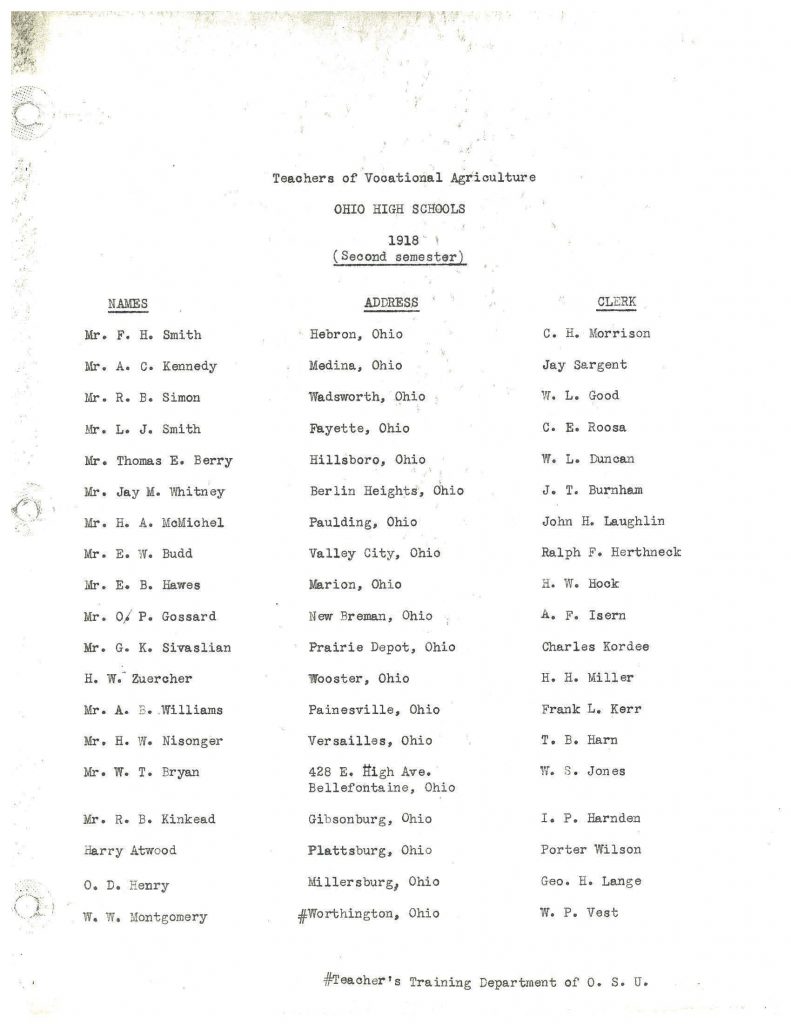Before the 1900s, the repairs and maintenance of farm equipment were quite simple. The engineering of farm equipment did not have the complexity of modern day farm equipment, which made servicing an easier task. The early 1900s was a time when homesteads and farms used candles for lighting, small plows for tilling, manual labor for planting, and a sickle for harvesting. There were a few schools teaching vocational subjects, where young boys learned mechanical work and young girls’ learned homemaking. According to Willard Wolf (1969), 50 of the 225 township schools in the state of Ohio in 1908 were offering agricultural education as part of their science courses. Communities recognize the need to teach youth the basics of agricultural sciences. The passing of the Smith-Hughes Act of 1917 helped agricultural education gain its momentum in the 1920s. This act provided more funding for high school instruction in agricultural sciences.
What agricultural sciences did vocational education programs teach? Agricultural education experienced rapid change with the increasing adoption of the tractor. Mechanical work on the farm shifted from simple tools like plows and rakes to tractors and electricity. Because of this modernization, everyday tasks on the farm in the 1920s changed dramatically. Farmers in the 1920s transitioned to overhauling an engine, repairing worn mechanical parts, and wiring the farm shop. Modern day farming in the 1920s allowed farm machinery to reduce labor cost, increase food production, and improve farm management practices. Mechanization changed the job description of a farmer. Farmers became more than just producers; they became a farm mechanics. Because of the growth in mechanization and production agriculture, the industry faced the challenge of not having farmers who were mechanically skilled. This led to teaching more farm mechanics in Vocational Agriculture Programs.
With farm mechanics and shop experiencing this major shift, there was a concern with whether or not teachers were teaching skills that match the demands of farmers and industry. A.C. Kennedy, a graduate of the Department of Agricultural Education at The Ohio State University with a master’s degree 1926, explored this inquiry by performing a study on the needs for training in farm mechanics in Ohio. This study was vital to developing effective instruction in farm mechanics. Kennedy studied the following problems:
- What kinds of mechanical jobs do farmers perform?
- What is the ratio of the amount of construction and repair work done?
- What, in the opinion of the farmer, is the relative importance of the difference phases of mechanical work done on the average farm?
- Would farmers do a greater variety of jobs if they were trained to do them?
By the 1920s, people were wiring their homes, using tractors to plow and plant their fields, and combines to harvest their crop. The classic blacksmithing, harness making, and carpentry work were skills that vanished quickly because of mechanization and modern technology. This change generated a need to train young farmers the necessary skills to maintain and operate an efficient farm. Kennedy studied this need and found that new construction in woodwork, farm machinery repair, harness repair, and painting were the most important tasks performed on the farm. Consequently, vocational agriculture education taught these skills more effectively.

A Study of the Needs for Training in Farm Mechanics in Ohio” by A.C. Kennedy. This map shows by countries, the location of the farms where the Farm Mechanics Surveys were taken.
It was easy to convince farmers and young boys to participate in farm shop programs because young farmers took pride in their mechanical skills, were eager to get their hands dirty and learn new technologies. Farmers saw farm construction and woodworking jobs for livestock, crops, gardening, shop, and household appliances as the most important job task for young farmers to prepared for. They also needed to learn metalworking, farm machinery repair, concrete work, painting, plumbing, tool sharpening, rope work, and harness repair. Along with the traditional farm mechanics, farmers wanted to install modern conveniences like electricity, water system, sewage disposal system, hot water, and heating plant. Kennedy studied determined that farmers were interested installing these modern day conveniences, but they did not know how to do the work themselves. Even though agricultural education was on the rise, there was an uncertain with what teachers should be teaching in the classroom. Indeed, they knew that teaching farm mechanics and business management was a vital skill that these young farmers needed to know.
Agriscience education student Cody McClain researched and compiled the information in this post.
This post is part of a series on our blog. To read all of the posts on the history of agricultural mechanics throughout the last 100 years, visit our archives.















